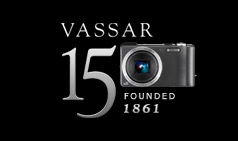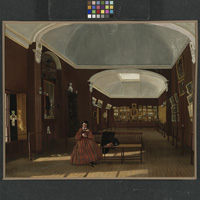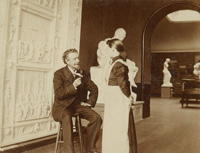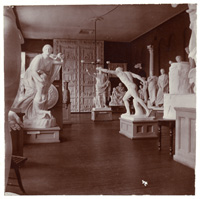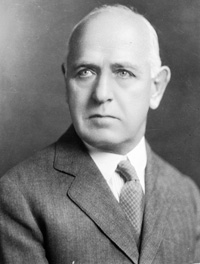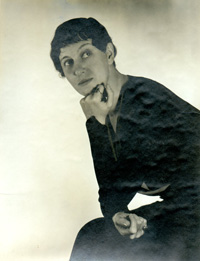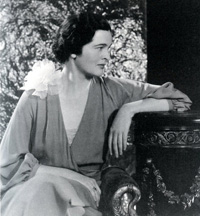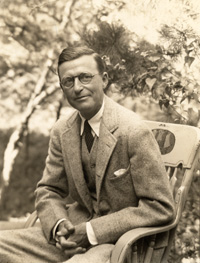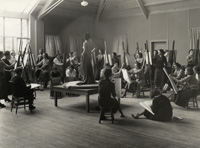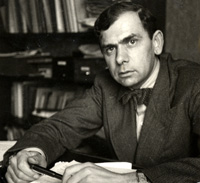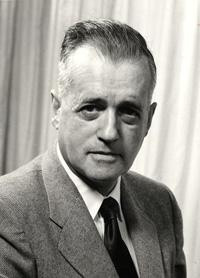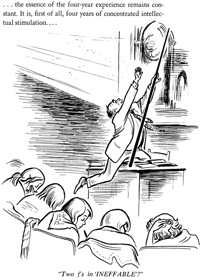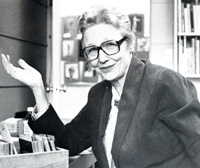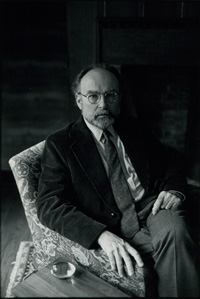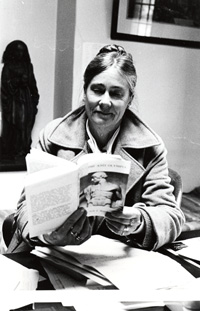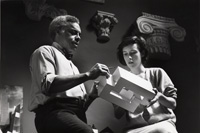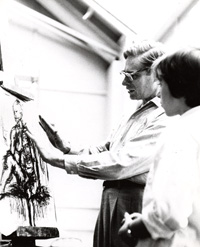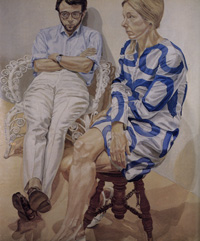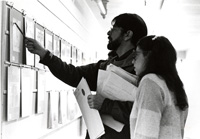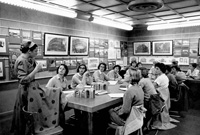The History of Art at Vassar College
Susan Donahue Kuretsky (’63), Sarah Gibson Blanding Professor of Art, and Nicholas Adams, Mary Conover Mellon Professor in the History of Architecture with assistance from Nicole Weindling (‘10), Sophia Alexandrov (’11) and Maria Emilia Fernandez (’13)
March 2011
Department Website
The teaching of art at Vassar College was planned from the very start--and specifically from original works -- as indicated by the central position of a gallery in James Renwick's plan for the fourth floor of Main Building. Indeed, Vassar was the first American college or university to integrate instruction and exhibition within premises earmarked for that purpose. The initial 353 students arrived in 1865 to find an art gallery installed with the modern art of the day: small Hudson River School landscapes, purchased for the impressive sum of $20,000, from trustee and art collector Rev. Elias Magoon along with his extensive collection of drawings, engravings and etchings and his art library.1 That Vassar's gallery predated by several years the founding of American public museums in the late nineteenth century speaks volumes about the boldness and fresh thinking of the college's founder and his early advisors and trustees, among whom were Milo Jewett, the educator who encouraged Mathew Vassar to found a college for women, the painter and inventor Samuel F.B. Morse, the journalist and illustrator Benson Lossing and Martin B. Anderson, President of the University of Rochester and a noted Baptist educator, who gave art lectures at his own institution. All understood that serious study--in art no less than in laboratory science--called for serious equipment. Thus, in 1864 the Committee on the Art Gallery (chaired by Rev. Magoon) had recommended for the gallery an extensive acquisition of authentic original works, diverse in medium and subject, even making the distinction between original prints and printed reproductions (though the latter would later be used as teaching aids).
The art gallery and college chapel were side by side in Main, reflecting the thinking of a period that saw art as a manifestation of moral truth, and landscape painting in particular as a reflection of a divinely-created nature. Art was hailed as a civilizing force in promoting national identity and individual morality while fostering the ability to make informed visual distinctions and acquire the cultivated taste that young women could pass along to their children and communities. Although Vassar's early students were not required to study art and were not given academic credit for art courses, they were offered artistic self-development either through visiting the gallery or taking studio classes where they could wield the brush themselves. Lectures on art were first offered in 1867, making Vassar the first woman's college to provide instruction in art history. 2
In 1877 the college established a separate adjunct School of Art, combining studio courses with art history lectures, that granted its own diploma. A decade later, elective courses in art history were opened to all students for credit. Although the art school closed in 1892, many of its courses were retained and given equal status with others in the curriculum. Art was listed for the first time within its own department in the college catalogue of 1892, but it is significant that even the earliest courses at Vassar concentrated on the subject for its own sake, not as an adjunct to another discipline like archeology, as was frequently the case elsewhere.3
The key figure in these early developments was an energetic and engaging Dutch landscape painter named Henry (Hendrik) van Ingen (1833-1898), who arrived at the college in the Fall of 1865 and would become known to decades of appreciative students (1865-98) as "dear Professor van Ingen." In addition to studio courses, Van Ingen offered instruction in art history and "criticism," encompassing topics in painting, sculpture and architecture. An enthusiastic booster of visual aids, he enlivened his lectures with the up-to-date technology of magic lantern (stereopticon) projection that he introduced to the Vassar classroom in 1879. During the mid-1870s he ordered nearly 1,000 Braun autotypes (an early form of mass reproduction of works of art) and the gallery also began to purchase an ever-expanding array of full-scale plaster casts after famous ancient and Renaissance sculptures from dealers in New York, Paris and Berlin.
By 1875 the gallery, much enlarged, had moved into Avery Hall, originally the Calisthenium (gymnasium) and riding academy, where it joined the museum of natural history. In 1915 the Art Department would find its permanent home in Taylor Hall, designed by the Boston architectural firm of Allen and Collens and specially built for the Art Department and Art Gallery. It was named for James Monroe Taylor, Vassar's president from 1886 to 1914, and given by his friend, the trustee Charles Pratt and his wife Mary Morriss '80, who also donated sixteen Italian paintings to the college in 1917 and a large collection of Chinese jades in 1917 and 1936. Taylor Hall replaced Renwick's small gatehouse to the college with a larger Main Gate (with space for a gatekeeper's apartment), set into an imposing Gothic revival structure where gallery, studios, art library, and a large lecture hall (meticulously renovated to preserve its original style in 2007) were for the first time combined under the same fireproof roof, though the space for art studios in the tower's top floor was initially occupied by the Department of Political Science. In 1937 the college built an addition, named in honor of Professor van Ingen, to connect Taylor Hall to the Main Library.
The years leading up to the construction of Taylor Hall were marked by increasing concern about the need for a safe and sufficiently commodious structure to house a growing art collection, as well as unceasing pleas for more photographs and better equipment from Lewis Frederick Pilcher (1871-1941), the department chair who served from 1901-1911. Pilcher was a practicing New York architect whose firm of Pilcher and Tachau designed both Jewett Hall (1907), with its steel and concrete core, and a faculty house at 79 Raymond Avenue. He was also the first to use electric projection for the lantern slides shown in his four-course art history sequence, covering medieval to modern, in which he emphasized chronology and historical development and insisted upon rigorous analysis of form.
The first academically trained art historian to lead the Art Department was his successor Oliver Samuel Tonks (1874-1953). A Harvard Ph.D. in classical archeology who had taught at Princeton (his specialty was the Greek vase painter Brygos), he expanded course offerings and faculty to bring the teaching of art history to a professional level. Tonks lived at 69 Raymond Avenue, a house he had designed himself, and began a long chairmanship (1911- 1943), reinstating studio courses in 1915 (which had not been taught since 1900) by hiring the painter Clarence ("Chatty") Chatterton (1880-1973), a friend of Edward Hopper. He also added offerings in ancient art, Italian sculpture, Dutch and Flemish art and architectural drafting (the latter first taught in 1931). In February 1913, not long after Tonks's arrival, the International Exhibition of Modern Art (Armory Show) opened in New York City. It proved to be a watershed event, introducing the American public, including much of the academic community, to abstract art. Its repercussions would be strongly felt at Vassar.
Tonks instituted new teaching methods with required readings, and courses taught in the preceptorial Princeton fashion as a combination of lectures with a weekly conference section—an arrangement that lives on in the department's venerable survey course, Art 105-106. He also stressed the importance of using the gallery as an educational tool for students in both classics and art. Tonks sought appointments among the sharpest and liveliest young art and architectural historians of the day, including Alfred Barr (1923-24), Henry-Russell Hitchcock (1927-28) and John McAndrew (1931-37). Among them was a young woman, Agnes Millicent Rindge (1900-1977, after 1945 Agnes Rindge Claflin), who became a temporary instructor at Vassar in 1923 and again in 1926, returning as Associate Professor in 1928 after the completion of her Radcliffe Ph. D. on the nature of sculpture. She soon became the vibrant center and guiding force of the department and would remain so until her retirement in 1965.
This writer (SDK), who was one of her last students, retains vivid memories of her electrifying presence in the department. Witty and sharply critical (comments on term papers, inscribed in inimitable, nearly illegible calligraphic loops, were often pondered for weeks by their terrified recipients), she was imposing in manner and appearance, especially to any student called in to confront her brilliant blue gaze. Every morning she arrived at Taylor Hall from her apartment in Williams, fashionably dressed and coiffed and surrounded by a cloud of Ma Griffe and delicate trails of cigarette smoke from which terse pronouncements ("ignorance is rampant") and the occasional deep chuckle would emerge. The wheelchair she used in later years only magnified her powerful presence since she occupied it, legs elegantly crossed, as if it were a throne. Claflin's lectures, given without notes, were seemingly spontaneous conversations with the audience—dense, elliptical, often amusing, and punctuated by mysterious, unexplained references ("Manet et manebit"). One's close attention was constantly rewarded, however, with startling moments of revelation in which images on the screen came so utterly to life, even in black and white slides, that one felt suddenly plugged into the very creative process of a Bruegel or a Degas.
In 1928, the year of Agnes Rindge's arrival at Vassar, a new college curriculum introduced the concept of major fields and distribution groups (Group I included Art, English, and Music). As a result, art history offerings were broadened and focused to include advanced work, while expansion of the art survey to two terms, now taught by "the department," marked the beginning of Art 105 as we know it today. In addition to her participation in this course, Rindge endured the crushing teaching load of that period: fifteen hours a week, including an introductory survey of modern architecture, another course in Renaissance to modern sculpture, lectures in the Italian painting course and, in the second semester, an advanced course on Spanish art for which students were required to read Spanish and either French or German.
Leila Cook Barber (1903-1984), who joined the faculty in 1931 after receiving her M.A. from Radcliffe, spoke with dramatic Bryn Mawr intonations and had a tall, Hepburn-like elegance which created a stunning classroom presence. She was immediately put in charge of Art 105 whose enrollment had soared to 162 students--every single one of whom she taught (and graded) in eleven weekly conference sections. She also contributed survey lectures and taught smaller courses in ancient and medieval sculpture. Not surprisingly Rindge's hope that her new colleague would institute a course in "oriental art" was not to be fulfilled for some time. Although her courses would later concentrate on central Italian painting, Barber's close supervision of Art 105 (though not her teaching load) continued until her retirement in 1968. Cecil (Lee) Striker, who taught medieval art at Vassar (1962-67) before moving to the University of Pennsylvania, recalls that teaching in Art 105-106 was not permitted immediately: "New faculty could not teach in it in their first year until they were vetted in other courses by Agnes or Leila." Today the Weitzel-Barber travel prize, an endowment established by Mary Weitzel Gibbons Landor ('51), honors Leila Barber by sending current Vassar students in both art history and studio art to "go to the source" and travel the world to see works of art or sites relating to their special interests.
In 1930, Rindge daringly added a new course in Italian baroque, a field then being revived by a circle of avant-garde scholars, museum directors and art dealers who saw in its dramatic content and vivid brushwork parallels with modern movements like expressionism and surrealism. 4 Although modern art lectures at Vassar were initially retained by Tonks (a classicist and traditionalist at heart), it was Rindge who soon inspired the intense student involvement that would later yield generous gifts and bequests to the gallery in twentieth century art, but also in baroque and in Old Master prints. A major bequest from the Warburg family in 1941 brought to Vassar more than 150 etchings, engravings, and woodcuts primarily, by Dürer and Rembrandt that have been regularly used in teaching ever since.
The construction of the Art Library in 1937, which would be the catalyst for subsequent expansion of the faculty, in ambition as well as numbers, marked an important achievement for the department. Designed by architect and faculty member (1931-37) John McAndrew (1904-1978), this modernist space sat within the Gothic frame of van Ingen Hall, forming a bridge to the Main Library. McAndrew had been a friend of the architect Philip Johnson and they had traveled together through Europe, so he brought to Vassar the most up-to-date modern design. 5 He left Vassar to become curator of architecture at the Museum of Modern Art in New York. The Art Library was a radical teaching tool, the first specialized art library for undergraduates in the country. And it was a sign of the college's seriousness about the study of art history. The Library received, at the time of construction, a grant from the Carnegie Foundation for the purchase of art books and McAndrew, himself, donated a collection of books on modern architecture including first editions of texts by Le Corbusier and Frank Lloyd Wright. Students from this period, like Esther Gordon Dotson ('39), who went on to a distinguished career at Cornell University after teaching at Vassar (1943-54), remembered the opening of the new Art Library as an event of special significance. In 2007, a stunning renovation of the Art Library by the architectural firm of Platt Byard Dovell & White renewed John McAndrew's modernist plan and updated it for modern technological needs. Laptops now commonly replace pens and paper, and where there were once mounted photographs on hooks, flat screens offer students the chance to project digital images for collective study.
Agnes Rindge's involvement in the art of her own time (evident in her 1929 book Sculpture, which treats the subject from a contemporary point of view) was sharpened and stimulated by friendships with such pacesetters in the arts as Alexander Calder, Alfred Barr, Philip Johnson, Eugène Berman, Pavel Tchelitchew, and Lincoln Kirstein. These friendships were central to her activities within and beyond Vassar, including her appointment in 1941 to the advisory committee for the Museum of Modern Art (founded in 1929) after its relocation to 53rd Street. In 1942 a major exhibition of the works of Calder and Mirò opened at Vassar: an ambitious project for a small college gallery. Soon thereafter the galleries on the second floor of Taylor Hall were redesigned (recalling the Art Library) in state-of-the-art modernist style by the New York firm of Ketchum Gina Sharpe.
In 1943 Agnes Rindge became both Chair of the Art Department (until 1965) and Director of the Vassar College Art Gallery (until 1962, when Thomas J. McCormick, a scholar of eighteenth century art and architecture, took on the directorship along with teaching American art). Rindge's prolonged and weighty service, unthinkable to a teaching member of a college faculty today, centralized administrative authority in the persuasive voice of one person who had the highest standards and a clear vision of building a department that would enrich all students' experience as undergraduates, connect them to current developments in art and art history, and offer serious training to those headed for professional careers. After her death in 1977, the Agnes Rindge Claflin Fund was established under the auspices of the recently (1974) founded Friends of the Art Department and Art Gallery as an endowment to support the presentation and publication of lectures and exhibitions, allowing students to both hear and meet distinguished artists, and art and architectural historians who are invited to the campus every semester. 6
Between 1937 and 1940, in the wake of the construction of the Art Library, two émigré German art historians were invited to join the Vassar faculty and, as a result of their presence, they were joined by a third, thus giving the department a European scholarly presence that continued into the late 1950s. 7 Richard Krautheimer (1897-1994) and Adolf Katzenellenbogen (1901-1964) brought connections to the German founders of the field of art history. Krautheimer had studied with Paul Frankl and Katzenellenbogen had studied with Erwin Panofsky and Fritz Saxl: together they represented the traditions of formal analysis and iconography from the roots of the field. Krautheimer, in particular, due to his longevity and his joyful memories of his years at Vassar, had a particular impact. He maintained contact with Agnes Claflin until her death in 1977 and with Pamela Askew, Vassar's specialist in Italian baroque painting, for the rest of his life. Even years late he happily remembered the details of his teaching schedule, relishing stories of collegial banter and the vicissitudes of Art 105-106. In the year of his arrival Krautheimer published the first of his meticulous studies of the history of the early Christian basilica in Rome, the Corpus Basilicarum Christianarum Romae. Starting in 1938 he also taught at the Institute of Fine Arts at New York University but only moved to NYU permanently in 1952. The long connection between Vassar and the Institute (which continued in later years) proved beneficial for a generation of students, raised under Krautheimer at Vassar, many of whom then went on to the Institute to complete the Ph.D.
Sophisticated, urbane, witty, and deeply learned, Krautheimer was a popular lecturer in Art 105-106 while his presence in the library could always be identified from his habit of talking to himself. He delivered the Commencement address in 1945 entitled "Higher Education Here and Abroad" in which he tried to come to grips with the extraordinary breadth of the liberal arts curriculum in America, always somewhat puzzling to someone raised in the more focused tradition of the German university. As he observed in a noted pun: "Man cannot live by breadth alone." Krautheimer's quandary was how to combine the sharp focus of scholarship with the wide-ranging character of the American curriculum. As is still the case, the architectural historian at Vassar taught everything from the middle ages to the present and Krautheimer was no exception. His regular lecture courses were entitled Roman through Gothic Architecture and Renaissance through Modern Architecture. His seminars addressed historical subjects in greater depth and Krautheimer argued for opening a second common seminar "Review and Correlation" as part of the curriculum. He also taught a course on Renaissance sculpture and one wonders how useful were the plaster copies of Ghiberti's Doors from the Florence Baptistery to him and his wife Trude Krautheimer-Hess as they worked on their monograph on Lorenzo Ghiberti (1956). Among his noted Vassar students was Phyllis Lambert ('48) who brought Mies van der Rohe to the attention of her father, then seeking to build a New York home for the Seagram Company. Her memories of Krautheimer the teacher and friend included reminiscence of his sharp eye and joyful appreciation for all architecture, from ancient to modern.
Adolf Katzenellenbogen was the medievalist (while Krautheimer, one of the most distinguished of the world's medievalists) served as the architectural historian, setting high standards for both positions. Katzenellenbogen started at Vassar in 1940 (as a visiting lecturer) and became assistant professor in 1943. He left Vassar for Johns Hopkins in 1958. Noted for his work on the iconography of medieval art, his major work was a study of the sculptural programs at Chartres Cathedral (1959). What did he and Krautheimer, the two émigrés, talk about together during the war? Katzenellenbogen had been imprisoned briefly at Dachau and the Krautheimers had fled Germany for London before coming to the United States. In 1942 Krautheimer published his renowned analysis of the iconography of medieval architecture. Was that, in part, a response to the experience of working shoulder to shoulder with a noted student of iconography? Was Katzenellenbogen the basis for the figure depicted lecturing and gesticulating at the screen in Anne Cleveland's ('37) witty Vassar cartoon, or is it a mixture of Krautheimer and Katzenellenbogen? 8
Krautheimer was succeeded by another architectural historian from Germany, Wolfgang Lotz (1912-1981) who came to Vassar in 1952 and left in 1959, once again to succeed Krautheimer at NYU. Where Krautheimer was ebullient, outgoing, and energetic, Lotz was more withdrawn, a man with a subtle mind, alternately troubled and amused by the complexity of the world. He was overwhelmed to succeed "the great Krautheimer" at Vassar, later protesting that he couldn't compare with his predecessor but, by assiduous reading, had at least hoped to know more than the students. After becoming director of the Biblioteca Hertziana at the Palazzo Zuccari in Rome, he invited the Krautheimers to join him there: Vassar's connection to the methods of founders of art history, communicated directly to an American faculty, had a significant long-term influence on teaching and expectations for scholarship in the department.
The presence of the German scholars changed Art 105-106 too. In the 1930s, the syllabus had been packaged in a colored cardboard cover with pithy evaluative commentaries for each artist: Titian, the syllabus explained in 1937, "Supreme Technical Performance in Entire Range of Accomplishment; Magnificence, Vitality; Golden Tonality"; or Veronese, "Continuation of Early Venetian Pageant Painting, Transformed into Sumptuous High Renaissance Decoration; Silver Tonality." This format continued until 1953–54 when a new syllabus appeared that combined a summary paragraph about each artist, with an historical introduction to each period.
This simple change in the syllabus corresponded to a major shift in teaching methodology that had already been underway for more than a decade. The key figure was Krautheimer. "Krautheimer," recalled Esther Dotson, "liked to talk about style, and we became hypnotized by the analysis of style as style…..Before, the course had been about the values in the works but not about the stylistic systems." Together with Linda Weinberg Nochlin ('51), who had been her student in Art 105 and was later on the faculty (1952–80), Dotson rewrote the syllabus. "The old syllabus was about progress. It was very much oriented to quality in the Harvard tradition." And the changes have held a half century later.
In the 1960s a new generation of faculty followed those who had directed the department through the war. Alabaman Alfred Frazer (1958-66), an architect and a specialist in ancient and early medieval architecture who had worked with Krautheimer on the Corpus Basilicarum Christianarum Romae, came to replace Lotz before moving on to Columbia. This part of the curriculum then became the province of Richard Pommer (1966-1987), a baroque specialist who later focused on modernism and followed Krautheimer and Lotz (whose student he had been at NYU) to the Institute. Pommer explored architecture's social context in his studies with Christian Otto of the Weissenhof Seidlung. The current writer (NA) recalls being transfixed by his article on the Art & Architecture Building at Yale published in the Burlington Magazine in 1972––the least likely location it seemed––and thinking if that was the way one could write architectural history then it might be worth doing! Linda Nochlin, who publishes widely in the field of nineteenth through twenty-first-century art, had moved on somewhat earlier, first to CUNY and Yale and finally to the Institute. Passionate, poetic and formidably articulate, she converted "overnight...like Saul on the road to Damascus" to the Women's Movement in the Fall of 1969. Surely no undergraduate art history seminar has ever been more groundbreaking than the one (Art 345b) she taught at Vassar in the Spring of 1970, entitled "The Image of Women in the Eighteenth and Nineteenth Centuries." The far-reaching consequences of her initial involvement in the topic led her to write "Why Have There Been No Great Women Artists?" an article that has been hailed as the founding document for a new feminist art history, profoundly affecting the field as a whole. 9
Others came to Vassar and stayed, developing expertise in diverse fields and inspiring numerous students to go on to graduate school. Pamela Askew (1925-1997) ('46) who came to the department for a year in 1950-51, left to complete a Ph.D. at the Courtauld Institute in London and returned as the department's specialist in both Italian baroque and Venetian painting (1954-85), focusing her own work on Domenico Fetti and Caravaggio. 10 She brought to her students a refined eye, the highest academic standards and more, as recognized by the College Art Association's Award for Distinguished Teaching in Art History in 1988. In the words of one grateful alumna: "Exacting and gentle, rigorous and kind....not only did she care about the product of my intellectual efforts, she cared about the process as well...who I had become along the way." Christine Mitchell Havelock, Canadian-born and Harvard-trained with a specialty in Hellenistic sculpture, taught the art of Antiquity (1953-90). Havelock opened the year's lectures in Art 105 each Fall and former students and colleagues still remember her compelling presence in the room. "I still can see Christine Mitchell Havelock lecturing on Praxiteles and the Temple of Zeus at Olympia," writes one alumna, "as coolly aloof as gray-eyed Athena, the Goddess of Wisdom. To me at that age, she seemed the living embodiment of female intellect and power." Her younger colleagues agreed––though she would always laugh off her notoriety as a lecturer in Art 105. "It's just that I come first," she would say modestly. Havelock's involvement in developing a Women's Studies Program at Vassar for which she became an energetic fundraiser and the first Director (1978) was not unrelated to her subsequent research in art history: publication in 1995 of her book on the Aphrodite of Knidos and her successors. Eugene Carroll (1930- , at Vassar 1965-99) arrived to teach the history of Italian sculpture in 1965, and upon Leila Barber's retirement three years later added late Gothic through Renaissance painting in Central Italy. Also trained at Harvard, he has worked on the artist Rosso Fiorentino, helping to pioneer research in this area of Italian art with an exhibition of Il Rosso's graphic works at the National Gallery in 1987. In his lectures and tightly-run seminars he trained generations of students in the fine art of connoisseurship and close analysis (a visual acuity that has also made him responsive to artists of his own time). A new faculty member asking colleagues how to plan an undergraduate seminar was consistently told to "ask Eugene."
During this period studio courses continued to be taught by an exceptionally lively faculty, all leading artists in their own right: Alton Pickens (1917-1991) and Lewis Rubenstein (1908-2003) in painting, and in sculpture Concetta Scaravaglione (1900-1975) and Sidney Geist (1914-2005) who was also a Brancusi specialist. In 1984 a major in studio art was established which is now an extremely popular track for students in the department. Although drawing continues to be taught in the lovely old sky-lit studios on the top floor of Ely Hall, the Doubleday Studio Arts Building behind Main (a renovation of a former plumbers' and electricians' workshop completed in 1994) has opened more space for sculpture and printmaking. At this writing additional studio space for painting courses and for senior projects is found in a building at the edge of the campus, originally designed as the Poughkeepsie Day School by Jeh Johnson who taught architectural design on the third floor of Taylor Hall between 1964 and 2001. Johnson also designed (in two former service buildings behind Main) Vassar's ALANA Center for Multicultural Studies (1993) and the Susan Stein Shiva Theater (1994). Founder of the largest practice in the mid-Hudson Valley and later in practice in New York City, he sent more than 130 Vassar graduates on to architecture schools. Jeh Johnson gave so generously to students through his teaching and advising that after his retirement his colleagues were amazed to realize that the position he occupied had only been half-time. 11 It is now shared with Urban Studies as a full-time appointment, bolstered by a generous gift from Margaret McCurry ('64) that brings architects to campus each term for presentations and discussion.
With awareness of a long line of distinguished and dedicated predecessors, we strive today to maintain their innovative spirit and insistence on quality and depth of coverage even as we adapt to current needs and new instructional approaches. 12 By 2007 the practice of hanging the walls of Taylor Hall with mounted reproductions had come to an end as the department converted to digital projection after almost 150 years with photographs, slides, and the murky bound reproductions ("University Prints") earlier students will recall. A world of new technology has transformed the teaching of all classes, especially Art 105-106, while giving students their own access to brilliant digital images of works studied in class. Traditionally the survey course covered European art almost exclusively, although a lecture in American art was added in the mid 1980s, expanded when the position became full-time in 1988. The 2011 version of Art 105-106 displays a wider and decidedly more global vision than when the course began as important Asian, Islamic, African-American and Native American examples have been added to the canon of European and American monuments. Asian art became a full-time position in 1994 (though sadly at the cost of a full-time southern baroque specialist). African and African-American art are now offered in upper-level courses. Many students now pursue field work and internship opportunities in the New York museums and galleries, while art history majors write a required one-semester senior thesis that trains them in research techniques and scholarly thinking and writing through close consultation with a faculty mentor. Studio majors undertake a parallel project supervised by the studio faculty.
The most significant event for the Art Department in recent years was the opening, in 1993, of the Frances Lehman Loeb Art Center, largely through the efforts of Frances Fergusson, Vassar's ninth president and an architectural historian who fostered significant building and rebuilding on the campus. This event, along with the subsequent renovation of the Art Department (both designed by the firm of Pelli Clarke Pelli Architects, New Haven), yielded enhanced exhibition and storage space for the art collection along with new art history classrooms and offices in the old gallery spaces. 13 Access to original works of art for teaching both art history and studio classes has therefore greatly expanded through the neighborly presence of the museum in a structure that connects directly to Taylor Hall. Today's students enter the Art 105-106 lectures (still the largest course in the college) through a door adjacent to the museum entrance, while the smaller weekly conference sections take place in a classroom on the second floor of the Loeb—and very often within its galleries—two of which now exhibit materials for courses both within and beyond the department.
These recent developments bring our long history, in a sense, full circle. Between then and now the Art Department has thrived because an interest in art (both collecting it and teaching it) was present at Vassar from the very start, and has been steadily and consistently nurtured ever since. But this professorial account remains, of course, only part of the story, because any department lives primarily through the experiences of its students. From the most casual culture-seeker sampling Art 105 to the advanced senior major destined to become a future colleague in the field, our students continue to inspire our best efforts whose success is often only measured by the arrival of a picture postcard, years later, with a scrawled message: "I finally made it, and you were right. Thank you! "
Footnotes:
- 1. Magoon had obtained much of his collection from John Britton who had acquired many works from the English architect Sir John Soane. See Landscapes of Retrospection: the Magoon Collection of British Drawings and Prints, 1739-1860, The Frances Lehman Loeb Art Center, Poughkeepsie, NY, 1999, with essays by Brian Lukacher, Francesca Consagra, and Sam Smiles.
- 2. The first M.A. degree in Fine Arts in the United States was awarded in 1876 at Vassar to Elizabeth Cordin for a thesis entitled "The Progress of Art in Ancient Times."
- 3. This important point was made by Pamela Askew in her 1993 publication "The Department of Art at Vassar: 1865-1931," p. 61, and in her longer, unfinished manuscript on the early history of the Vassar Art Department to which this account is most gratefully indebted.
- 4. Proof of the obscurity into which the baroque had fallen is Oliver Tonks's The History of Italian Art, published in 1927, which skips from Tintoretto to Tiepolo, with no mention of Caravaggio or the Carracci, among others. Arthur Mc Comb, whose The Baroque Painters of Italy (1934) was the first survey of this material, taught art history at Vassar between 1924 and 1927. His daughter Pamela Askew, born in Poughkeepsie in 1925, would graduate from Vassar in 1946 and later become the Vassar Art Department's baroque specialist (1950-51, 1954-85).
- 5. Freed from a semester of teaching to complete the library design. McAndrew was replaced in the department by John Coolidge (later to become a Professor at Harvard and Director of the Fogg Art Museum) who was then studying architecture at Columbia University. Coolidge later returned to teach conferences in Art 105-106.
- 6. Two devoted and energetic alumnae, Carol Rothschild Noyes ('39) and Belle Krasne Ribicoff ('45) took on the administrative planning and implementation that created the Friends. Pamela Askew ('46), who worked closely with them as the Chair of the Art Department, dubbed the duo "Trylon and Perisphere" after the two modernistic icons of the 1939 World's Fair. Belle Ribicoff 's close connection to the Art Department continues today through the popular Ribicoff Seminar, led every year by a distinguished visiting scholar or museum curator.
- 7. Katzenellenbogen's wife Elizabeth, a master pianist, joined the Music Department along with another German émigré, the composer Ernst Krenek. Henry Noble MacCracken, Vassar's president from 1915-1946, was instrumental in bringing established foreign scholars to Vassar, having initiated programs to aid those seeking refuge in the United States (from Eastern European oppression in Poland in the 1920s and from the Nazi holocaust in the 1930s and 40s).
- 8. Katzenellenbogen, affectionately nicknamed "Mighty Mouse" by his teacher Erwin Panofsky, invited Panofsky to lecture at Vassar on 6 December 1944. His topic "Gothic and Scholasticism," gave Vassar students a preview of material that would later appear in his classic study Gothic Architecture and Scholasticism (1951). Thanks to Hélène Lipstadt, via Molly Nesbit, for this information.
- 9. Art News, 69, January 1971: 22-39, 67-71.
- 10. Daughter of Arthur McComb, who had taught art history at Vassar in the mid 1920s and later published the first survey of baroque art (see note 4), Pamela was the stepdaughter of the art dealer Kirk Askew whose salon in New York was a meeting place for scholars and artists, including modernists like Agnes Rindge Claflin, who became interested in reviving the baroque. Her involvement in that field was literally bred in the bone.
- 11. Courses in architectural practice began early at Vassar with John McAndrew's appearance in 1931 and with Jeh Johnson's predecessor Elizabeth (Betty) Meade (1905-1983) ('27), an MA in landscape architecture from Smith, who was hired in 1932 as a visiting lecturer to teach landscape architecture, a field previously taught in the Botany Department. Alfred Frazer briefly taught architectural drawing, but soon recruited Jeh Johnson to come and take over that instruction.
- 12. In 1998 the Slide Room in Taylor Hall, long the arena for Nick de Marco, a curator of slides, and originally the assistant for Agnes Claflin, shifted in its supervision from the Art Department to the Main Library to become a wider institutional resource (the Visual Resources Library) for expanding interdisciplinary study in the college. Since 1991-92 the Director of the Gallery, no longer reporting to the Art Department Chair, has also been given a broader administrative role, comparable to that of the Director of the Main Library.
- 13. During the planning of the new museum the Friends of the Art Department and Art Gallery, under the directorship of Anne Holton Bushman ('44), offered vital assistance by leading the fundraising drive to add four crucially needed twenty-foot-square bays along the Raymond Avenue side of the structure, without which this building could not have become the teaching museum it is today.
References:
- Adams, Nicholas, “Some Things Never change, or do they?” Vassar Quarterly 98: 4 (Fall 2002, 4-5).
- Adams, Nicholas; Ackerman, James; Askew, Pamela (on Krautheimer at Vassar); Lambert, Phyllis; Coolidge, John; Smyth Craig Hugh “In Memoriam: Richard Krautheimer (1897-1949,” Journal of the Society of Architectural Historians, 54, (1995) 4-7, 115-121.
- Askew, Pamela, “The Department of Art at Vassar: 1865-1931,” in The Early Years of Art History in the United States, ed. .Craig Hugh Smyth and Peter M. Lukehart, Princeton, 1993, 56-63.
- Askew, Pamela,” A Galaxy of Stars,” (published posthumously) in Refining the Imagination: Tradition, Collection and the Vassar Education, The Frances Lehman Loeb Art Center, Poughkeepsie NY, 1999, 15-25.
- Askew, Pamela, Unpublished manuscript on the early History of the Vassar Art Department.
- Buchsbaum, Adam, “Team-taught Art 105-106: a Vassar classroom classic from the start,” The Miscellany News, CXLIV, issue 14, February 10, 2011, p. 14. Lukacher, Brian, Consagra, Francesca, and Smiles, Sam, Landscapes of Retrospection: the Magoon Collection of British Drawings and Prints, 1739-1860, The Frances Lehman Loeb Art Center, Poughkeepsie, NY, 1999.
- Daniels, Elizabeth A. (Director) et al. On-line Encyclopedia of Vassar College
- Daniels, Elizabeth A., “1974-1999: A Quarter Century in Support of the Arts by the Friends of the Frances Lehman Loeb Art Center,” in Refining the Imagination: Tradition, Collection and the Vassar Education, The Frances Lehman Loeb Art Center, Vassar College, Poughkeepsie, 1999, 27-34.
- Kuretsky, S.D., "Dürer and Rembrandt in Academia," in Limouze, D., The Felix M. Warburg Print Collection. A Legacy of Discernment, The Frances Lehman Loeb Art Center, Vassar College, Poughkeepsie, NY, 1995, 23-45.
- Kuretsky, Susan Donahue (’63) and McDonough, Yona Zeldis (’79), “Remembering Pamela Askew ‘46,” Vassar Quarterly Winter 1997: 2-3.
- Lynes, Russell, intro. et. al., An Exhibition in Memory of Agnes Rindge Claflin 1900-1977. Professor of Art and Director of the Vassar Art Gallery. Poughkeepsie, 1978 (includes eulogies by Henry-Russell Hitchcock, Richard Krautheimer and Barbara Knowles Debs).
- Magoon, E.L., Morse, S.F.B., Lossing, B.J., Thompson, J., Vassar.J.G., “Report of the Committee on the Art Gallery of Vassar Female College, 1864,” in Claflin, A.R., Intro., Vassar College Art Gallery. Selections from the Permanent Collection, Poughkeepsie N.Y., 1967.
- Mundy, E. James, “The History of the Art Museum of Vassar College,” in Prestel Museum Guide. The Frances Lehman Loeb Art Center, Vassar College, The History and the Collection, Munich, Berlin London, New York, 2007, 4-15.
- Musacchio, Jacqueline Marie, Copies, Casts and Pedagogy: the Early Teaching of Art and Art History at Vassar College, Frances Lehman Loeb Art Center, Poughkeepsie, 2006.
- Nochlin, Linda. "Why Have There Been No Great Women Artists?" Art News, Vol. 69, January 1971: 22-39, 67-71.
- Nochlin, Linda, “Vassar, Art and Me, Memoirs of a Radical Art Historian,” Vassar Quarterly, 90, no. 2, Spring 1994, 20-24.
- Plum, Dorothy A. and Dowell, George B., The Magnificent Enterprise. A Chronicle of Vassar College, Poughkeepsie, 1961 (written for the Centennial).
- Ribicoff, Belle Krasne et. al., Centennial Loan Exhibition: Drawings and Watercolors from Alumnae and their Families, Vassar College, Poughkeepsie, New York and Wildenstein & Co., New York, New York, 1961.
- Tonks, Oliver S. “The Art Department at Vassar College,” Vassar Quarterly, February 1935, 26-29.
- “Panofsky at Vassar,” Vassar Chronicle, 2, 1944, 7.
- https://vcencyclopedia.vassar.edu/collections-curiosities/plaster-casts.html
- https://fllac.vassar.edu/about/articles/drawings-at-vassar.html
